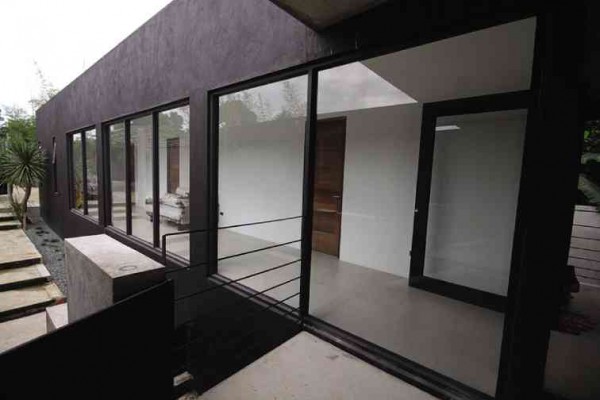
A house painted in black should be easy to spot, but visitors to Jinggoy and Mutya Buensuceso’s new home in Cavite, will have to keep their eyes open or they’ll drive right by it.
Despite its nontraditional color and retro-modern blueprint, the compound somehow manages to blend in with its rural surroundings.
The house follows a visual concept: It is as if “a giant dropped a black cube in the forest,” explained Jinggoy, an innovative visual artist and member of Kenneth Cobonpue’s design team, the Hive.
Instead of a traditional single structure with rooms, he conceived separate boxy structures with large windows to draw in floods of natural light. Oversized glass doorways slide or pivot wide open, blurring the border between indoor and outdoor spaces.
In place of hallways, these “rooms” are linked by open breezeways where family and friends can gather for conversation in fresh air.
“You can step out (of the room) still talking, but you may never get around to leaving,” he teased.
The residence is still under construction, but the creative couple’s touches are already evident, starting with Jinggoy’s unusual choice of non-color.
Black is positive
“Black for other people is full of negativity,” he acknowledged. “But if you put all colors together, the result is black. It is full of character, ideas and concepts, so for this family, it is full of positivity.”
The finished main living space, which includes the kitchen and dining area, has crisp white walls and cool stone-tiled floors, in contrast to the rough textures and earthy tones found outside.
“He wanted a ‘push and pull’ of polished areas versus industrial or natural areas,” explained Mutya, as her husband pointed to the breezeway’s ceiling, where he had used plywood to mold the concrete with a natural wood grain pattern.
The dwelling is also multi-functional. Aside from being a home for the couple and their children, 3-year-old Mayumi and 18-month-old Malaya, it will also serve as a de facto art gallery, showcasing the works by Jinggoy and fellow artists.
The house already holds several of his sculptural furniture, such as the angular “Linear Birds” garden installation, created for an upcoming pop-up shop of hip home store Bungalow 300, and a quartet of wing-like chairs beckoning from the patio.
He named them “Moth Chairs” for the insect they resemble, but Jinggoy said their graceful design also reminds him of his grandmother.
“From the back, you’ll notice [the silhouette of] a very singkit eye. I was inspired by my lola’s eyes, so I also call it the ‘Conching Chair.’”
‘Doodle’
The pieces will have a new home later this year, as they have been donated to lifestyle doyenne and children’s advocate Daphne Osmeña-Paez for her annual Unicef “Auction for Action” benefit.
Inside the house, arranged around the dining table, were other pieces, such as his award-winning “Spider Chair” and a pair of vintage looped metal frames covered in goat hide and converted into stools.
However, easily the attention grabber was his “Doodle Library”—a tangle of bright-red, powder-coated aluminum that functions as a bookshelf. The Doodle collection, with its playful lines, includes chairs and lamps. Jinggoy got the idea for this when, in Cebu on a visit to a school for special children, he spotted a young boy’s drawings on a blackboard.
While Jinggoy answered questions about his art, Mutya bustled between the kitchen and dining area, preparing lunch.
An incomplete house is no obstacle to stylish entertaining for this equally creative woman, who juggles domesticity with a career as country manager for Luxasia Philippines. With no fancy linen or silverware, this beauty queen-turned-corporate executive (Mutya Crisostomo was Mutya ng Pilipinas in 1990) imaginatively made use of the meal itself as lovely table décor.
Fragrant herbs tumbling from delicate white cups flanked a fresh bouquet of ruffled lettuce leaves in a wooden bowl. Enormous fuchsia dragon fruit and small condiment dishes of pungent kimchi provided vivid pops of color.
The centerpiece was Jinggoy’s rustic presentation of pork belly, perfectly pan-roasted with a knotted thatch of lemongrass and whole garlic bulbs, and served with generous spoonfuls of creamy coconut sauce.
Chunks of crunchy skin and juicy pork were dabbed with choice of dips and sauces, garnished with herbs, and then wrapped in lettuce leaves.
Finally, wedges of pitaya and juice from fresh passion fruit procured from a neighboring farm capped off the marvelous meal.
Leaving the house painted in black, one might wonder how the Buensucesos could seem so comfortably settled in their unfinished residence. The answer is simple: They envisioned a home that essentially will never be complete.
“The rusting of the gate, the finish of the walls—it will all change. Not deteriorate [but transform],” mused Jinggoy. “I believe in kinetic things. Days pass, years pass—you don’t stop at one particular time. The soul is always there, but the character around it will always be developing and moving.”